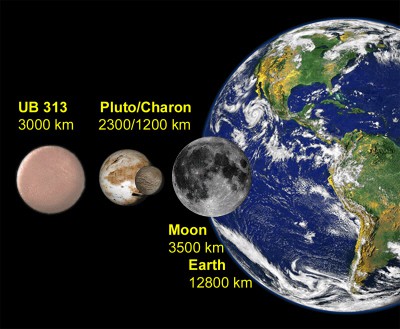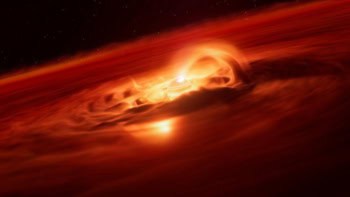Claims that our Solar System has a tenth planet have been supported by new results from astronomers in Germany. Frank Bertoldi of the University of Bonn and colleagues have found that "2003 UB313" -- an icy object that was discovered last year lying beyond Nepture -- is actually larger than Pluto itself. Although previous estimates suggested that it was at least as big, Bertoldi's team have now measured its size accurately and found that 2003 UB313 is 700 km larger in diameter (Nature 439 563).

UB313 was discovered by Mike Brown and colleagues of the California Institute of Technology in January 2005. It is one of a vast band of small, icy bodies lying in the “Kuiper belt” beyond Neptune. Lying almost twice as far from the Sun as the most distant point of Pluto’s orbit, it is the most distant known object in the solar system.
Astronomers initially suspected that UB313 was bigger than Pluto based on measurements of the fraction of visible sunlight that it reflects into space. The fraction is known as the “albedo” of the object. But these measurements were tricky because UB313 is so far from Earth. They also assumed that the body reflects light at optical wavelengths, like Pluto does.
Bertoldi and colleagues have instead measured the thermal emission of the object. Using a telescope operated by the Institute for Millimetre Radio Astronomy in the Sierra Nevada mountains in southern Spain, they measured the amount of heat radiated by UB313 at a wavelength of 1.2 mm, where the light reflected from the Sun is negligible.
The results, combined with optical measurements, reveal that UB313 is about 3000 kilometres across. This is bigger than Pluto by 700 km and also makes it the biggest solar system object to be found since Neptune was discovered in 1846. “Since UB313 is decidedly larger than Pluto, it is now increasingly hard to justify calling Pluto a planet if UB313 is not also given this status,” says Bertoldi.
“The discovery of a solar system object larger than Pluto is very exciting,” says team member Wilhelm Altenhoff of the Max Planck Institute for Radio Astronomy, also in Bonn. “It tells us that Pluto, which should properly also be counted to the Kuiper Belt, is not such an unusual object.”
The results also suggest that other “transneptunian planets” may be lurking undiscovered in the far reaches of the Solar System. But whether astronomers will accept UB313 as a planet is far from clear.



